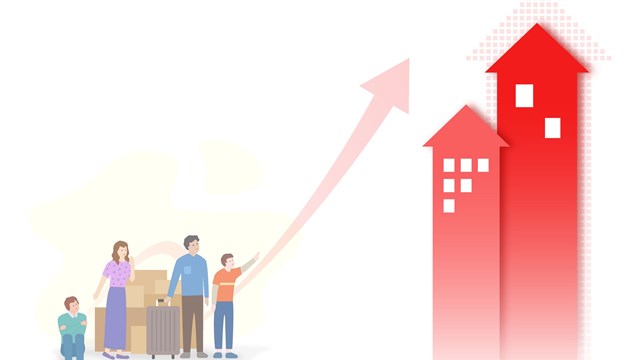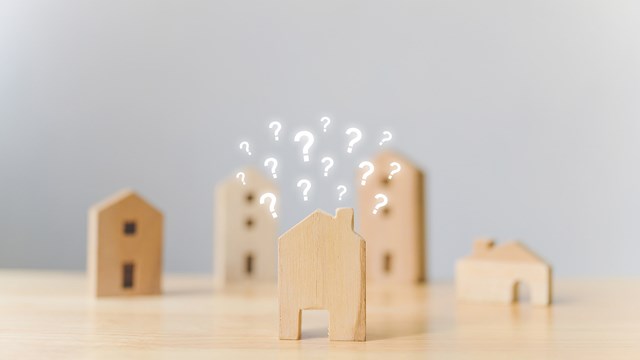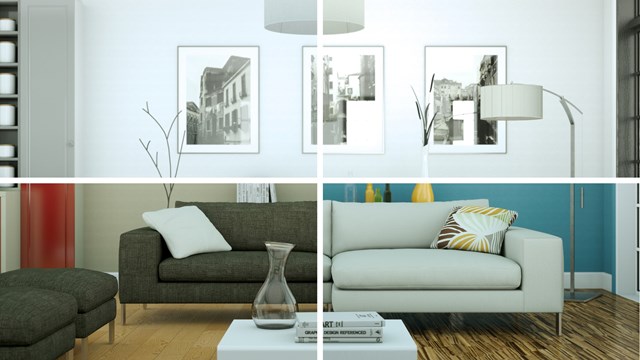In theater, film and television, a set designer is a vital artistic component for a successful production. He or she designs a set that generates a specific mood or atmosphere and hopefully—if the job is done properly—the audience will experience the same emotions.
When you are selling your home, you may also want to do to your home what a designer does to a set; transform it to create an atmosphere that a potential buyer—your audience—can picture themselves living in. This transformation, called "home staging," goes beyond the simple designed-to-sell techniques that realtors ask homebuyers to carry out, such as organizing, cleaning and changing wall colors.
Barb Schwarz, president and CEO of www.stagedhomes.com, with offices in Concorde, California and Seattle, Washington, coined the phrase "home staging," almost three decades ago. She explains that your home has to be thought of as a product when it's time to sell. "The way you live in your home and the way we market and sell it are two different things," says Schwarz. "When you buy your house it becomes a home, but when you sell your home it becomes a product. Now the public is going to come through, and you want the public to buy the space, not your things. Your home needs to be staged."
Home as Product
Unfortunately, "staging" doesn't mean leaving cozy pictures of your family and kids on the mantle or creating that 'lived-in' feeling. According to Schwarz' definition, "Staging is the process of preparing any home for sale—regardless of price or location. Using a proven professional set of guidelines, your house is reviewed for compliance with preset standards, and any modifications are made, if necessary. Staging is done on a home's interior and exterior and may include removing clutter and personal items, repositioning objects, removing or adding furniture, painting and more. If your house is already vacant, stagers may even rent basic furniture items to complete a look."
Schwarz admits that getting the real estate industry to embrace this new concept wasn't always easy. She sold homes in the traditional way for several years before convincing a seller to try some of her then-unique ideas.
"One day," says Schwarz, "I told a seller to think of her house like a theater set. The audience is the buyers, I'm the director, and she—the homeowner—was the actor. I told her I had some ideas for staging the home, and she listened, and it worked."
From there, Schwarz has personally staged and sold more than 1,600 homes, and began traveling worldwide, eventually training more than 600,000 realtors on home staging techniques. Today, even the television industry has taken note and jumped on the home staging bandwagon. Several shows, such as HGTV's Designed to Sell, A&E's Sell this House and the BBC's House Doctorsare formulated on the home staging concept.
Cutting Corners In a Fast Market
In today's fast-selling real estate industry however, many homeowners might not believe in Schwarz' plan. According to the National Association of Realtors (NAR), an improving economy combined with low mortgage interest rates and an underlying demand for housing has kept total existing home sales in New Jersey near record levels in the first quarter of 2004. Forty-two states and the District of Columbia have experienced sales increases this year in comparison with the first quarter of 2003.
"Many homeowners think they shouldn't stage because their house is going to sell anyway," says Schwarz. "They need to think about the big picture. Yes, the house can sell right away and you might get multiple offers, but what if it wasn't messy and it was staged. How many offers would you have gotten then?"
According to a study posted on the www.stagedhomes.com site, staging can affect the sale price of your home, as well as the time it spends languishing on the market. A non-staged home stays on the market for an average of 30.9 days, while a staged home has an average stay of only 13.9 days. Staged homes also tend to sell for more than 6.3 percent over the listing price.
Stagers consider it their fiduciary responsibility to get clients the most money possible from their home, and to do that, home stagers offer their clients advice on both the interior and the exterior of their home. The following are some examples of the kinds of things stagers do to make properties more attractive and exciting to buyers:
• Clear all unnecessary objects from furniture throughout the house. Keep decorative objects on the furniture restricted to groups of 1, 3, or 5 items.
• Clear all unnecessary objects from the kitchen countertops. If it hasn't been used in three months, put it away! Clear refrigerator fronts of messages, pictures, etc. (A sparse kitchen helps prospective buyers picture their things in your kitchen space.)
• In the bathroom, remove any unnecessary items from countertops, tubs, shower stalls and commode tops. Keep only your most needed cosmetics, (brushes, perfumes etc..) in one small group on the counter. Coordinate towels to one or two colors only.
• Rearrange or remove some of the furniture if necessary. As owners, many times we have too much furniture in a room. This is wonderful for our own personal enjoyment, but when it comes to selling, we need to thin out as much as possible to make rooms appear larger.
• Take down or rearrange certain pictures or objecton walls. Patch and paint if necessary. Review the house inside room-by-room. Clean carpets or drapes that need it. Clean windows.
• If you need room to store extra possessions, use the garage or rent a storage unit.
• Leave on certain lights during the day. During "showings" turn on all lights and lamps.
• Have stereo FM on during the day for all viewings.
• The outside of your home counts just as much as the interior. When staging your home for selling:
• Go around the perimeter of the house and move all garbage cans, discarded wood scraps, extra building materials, etc., into the garage.
• Check gutters for roof moss and dry rot. Make sure they are swept and cleaned.
• Look at all plants—prune bushes and trees. Keep plants from blocking windows.
• Weed and then mulch all planting areas. Keep lawn freshly cut and fertilized. Remove and dead plants or shrubs.
• Clear patios or decks of all small items such as small planters, flowerpots, charcoal, barbecues, toys. etc… (Put them in the garage or a storage unit.)
• Check paint condition of the house—especially the front door and trim.
The Seller's Role
Home stagers admit that the homeowner can accomplish these concepts on their own—and many offer one-hour consultations complete with a to-do list like the one above—but point out that hiring a specialist does have its advantages.
"A third party can be far more objective and stringent with what gets packed away," says Christine Rae, president and owner of Decorating Solutions Inc. in Ontario. "If you're living in the house, you're too close; we have a different perspective. We're looking at selling the space, but you're looking at your memories. We don't look at that. Remember, an average buyer will look at your home for two to six minutes, and we want them to see something other than your memories."
Home stagers focus on key rooms, such as the living room, dining room, kitchen, family room and master bedroom. "We will work on children's rooms if they are particularly messy or have a ton of posters or other kid items that are prominent," says Darren Brand, a decorating consultant and owner of Designed To Sell.ca, in Toronto. "We also make suggestions to the homeowner. Today, people are obsessed with image and like to see something that looks good. Today, even model homes are staged."
Once the staging job has been completed, Schwarz says that it's important for the homeowner to commit to keeping it staged. "Once it is staged, don't go backwards," says Schwarz.
More Benefits of Staging
The length of time and the cost of working with a home stager will depend on what you need to accomplish and where your home is located. Prices are either per hour—from about $50 an hour and up—or per project.
"The price of your investment will differ," says Conni D'Emidio, ASP, owner of Take Center Stage, in Bayside, Queens, "but I try to work with what the homeowner has—I'll go on treasure hunts in your home and find beautiful things that should be out. In the yard, if you can't see it, you can't sell it. If you drive by a home with a lot of trees and bushes, the home doesn't have curb appeal. I recently staged a home where we painted bland shutters. It made the house look adorable. I've also staged RVs and boats."
Alejandra Ligotti, owner of Tango x 4, a staging firm in Manhattan, has had clients spend as little as $150 to stage the home in time for an open house to $5,000 on a four-bedroom home in poor condition that took her company about a week to complete. However, Ligotti explains that to some homeowners the rewards are beyond monetary.
"When you're moving, you're under a lot of stress, having to get ready to come out of that space, but a stager can help with the process. Not only does staging help sell the place faster and at a higher price, but we can help you remove clutter so you don't move so much stuff to your next home. This is a good benefit if you feel overwhelmed with the task of moving."
Staging School
To educate and train staging professionals, Schwarz founded the International Association of Home Staging Professionals and developed the "Accredited Staging Professional (ASP)" course and the "Master Accredited Staging Professional (ASPM)" course for industry professionals to earn an ASP and ASPM designation.
To become an accredited staging professional, a stager must complete an intensive 2-day training program that teaches specific techniques and concepts in home presentation and staging. This includes one day of classroom instruction and another day of actual hands-on staging in a real home that is on the market. Upon course completion, they are awarded the Accredited Staging Professional Credential, which allows them to professionally stage your home.
For further training, an ASP graduate is qualified to attend the Accredited Staging Professional Master Course. This is a 5-day course with hands-on training that includes the latest in business building and marketing ideas for stagers.
Home staging, according to Rae, is a marketing tool that every home can benefit from. "A home needs three things to sell, and it's not just location, location, location," says Rae. "It's price, location and condition. All three things need to be harmonized in order to make the sale. You can't change the location of your home, and the price comes from a realtor's expertise. We are affecting the condition of the home. We found a way to work with what the homeowner has with a minimum investment and maximum effort to showcase the space."
For more information, or to find an accredited staging professional in your area, visit www.stagedhomes.com.
Lisa Iannucci is a freelance writer living in Poughkeepsie, New York.






Leave a Comment